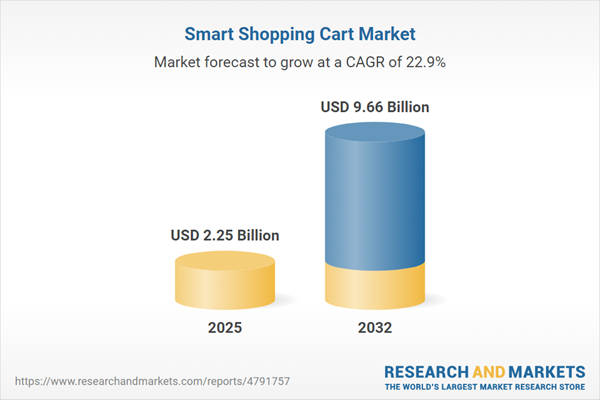Speak directly to the analyst to clarify any post sales queries you may have.
The smart shopping cart market is at the forefront of retail innovation, as intelligent hardware and software transform in-store experiences and drive operational efficiency. Stakeholders seeking competitive advantage will benefit from a clear understanding of fast-evolving market dynamics and technology adoption.
Market Snapshot: Smart Shopping Cart Market Trends and Outlook
The global smart shopping cart market grew from USD 1.85 billion in 2024 to USD 2.25 billion in 2025. Sustained momentum is expected, with a CAGR of 22.91% projected through 2032, bringing the market value to USD 9.66 billion within the forecast period.
Innovative features such as advanced sensors, intuitive displays, and integrated payment modules are driving adoption among retailers who are seeking to meet customer expectations and streamline store operations.Scope & Segmentation of the Smart Shopping Cart Market
This research report provides an in-depth view of the industry, segmenting the market by offering, technology, end-user, and region to enable granular strategic analysis.
- Offering – Hardware includes camera modules, payment systems, scanners, touchscreen displays (LCD, LED), and weight sensors; Service offerings cover consulting, installation and maintenance; Software platforms support these hardware and service components.
- Technology Type – Covers both bar code and RFID-enabled system deployments, catering to varying implementation needs and budgets within retail settings.
- End-User – The market serves grocery stores, shopping malls, and supermarket/hypermarket formats, each presenting unique operational requirements and customer engagement preferences.
- Geographic Regions – Analysis spans Americas (with North America and Latin America specificity), Europe, the Middle East & Africa, and Asia-Pacific; regional differences in infrastructure, regulation, and consumer behavior influence adoption rates.
- Leading Companies – Market players include Amazon.com, Inc., Caper Inc., Cart Technologies, Microsoft Corporation, SAP SE, Walmart Inc., and other technology and service providers shaping competitive dynamics.
Key Takeaways for Decision-Makers
- Smart shopping cart adoption is accelerated by the convergence of digital and physical retail, as operators seek more seamless, data-rich shopper experiences.
- Retailers benefit from enhanced inventory tracking, faster checkout, and the potential for real-time personalized promotions, all of which drive customer satisfaction and operational gains.
- Hardware manufacturers and software innovators are collaborating more closely to deliver flexible, integrated cart solutions tailored to a spectrum of store layouts and customer profiles.
- Region-specific regulations, especially regarding data privacy and trade, play a central role in deployment strategies, requiring localized approaches and compliance measures.
- Emerging partnerships and acquisitions indicate industry consolidation, as both established firms and startups pursue scale and technical leadership through ecosystem alliances.
Tariff Impact on Component Supply Chains
New tariffs introduced in the United States in 2025 affect a range of electronic components central to smart shopping cart manufacturing. Increased import duties on touchscreen modules and camera sensors have led manufacturers to diversify their supplier portfolios and pursue new production hubs outside high-tariff regions. Retailers and service providers must now balance higher upfront equipment costs with anticipated gains from more efficient store operations. For optimal outcomes, market participants should focus on agile sourcing, supplier risk management, and design changes that reduce exposure to affected components while meeting performance standards.
Methodology & Data Sources
The research leverages structured interviews with retail executives, hardware and software providers, and gathers field observations of smart cart deployments. Secondary sources—including industry publications, regulatory filings, and technology white papers—complement primary data. Rigorous, cross-validated segmentation and regional mapping enhance the reliability of the findings.
Why This Report Matters
- Senior decision-makers gain a comprehensive, segmented view of the smart shopping cart landscape to support well-informed investment and partnership strategies.
- Enables actionable benchmarking against leading companies, emerging disruptive innovators, and existing deployment outcomes across major geographies and retail channels.
- Equips stakeholders with clarity to navigate evolving technology, regulatory, and competitive landscapes—positioning teams for scalable, future-ready retail transformation.
Conclusion
The smart shopping cart market offers targeted opportunities for retailers, manufacturers, and technology partners to unlock new value through digital transformation. Decision-makers equipped with detailed, actionable insights are best positioned to drive efficient adoption, operational performance, and sustained customer engagement.
Additional Product Information:
- Purchase of this report includes 1 year online access with quarterly updates.
- This report can be updated on request. Please contact our Customer Experience team using the Ask a Question widget on our website.
Table of Contents
3. Executive Summary
4. Market Overview
7. Cumulative Impact of Artificial Intelligence 2025
Companies Mentioned
The companies profiled in this Smart Shopping Cart market report include:- Amazon.com, Inc.
- Caper Inc.
- Cart Technologies, LLC
- Cust2mate Ltd.
- Focal Systems Inc.
- Grabango Co.
- HiCart Corporation
- IMAGR Limited
- International Business Machines Corporation
- MetroClick, Inc.
- Microsoft Corporation
- Mitsui & Co., Ltd.
- Pentland Firth Software GmbH
- Retail AI, Inc.
- SAP SE
- Shopic Technologies Ltd.
- SK Telecom Co., Ltd.
- Standard Cognition, Corp.
- Superhii Corporation
- SuperSmart Ltd.
- Tracxpoint, Inc.
- Veeve Inc.
- Walmart Inc.
- Wanzl India Pvt Ltd.
- ZooZ by PayU Company
Table Information
| Report Attribute | Details |
|---|---|
| No. of Pages | 198 |
| Published | November 2025 |
| Forecast Period | 2025 - 2032 |
| Estimated Market Value ( USD | $ 2.25 Billion |
| Forecasted Market Value ( USD | $ 9.66 Billion |
| Compound Annual Growth Rate | 22.9% |
| Regions Covered | Global |
| No. of Companies Mentioned | 26 |









